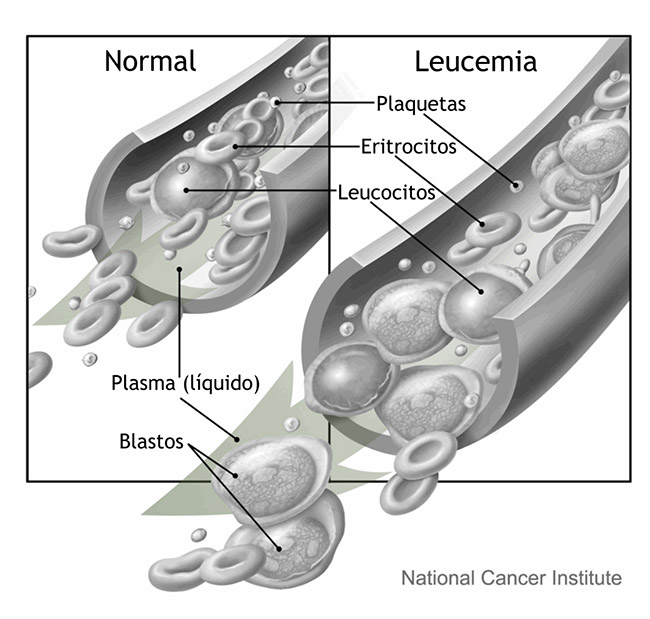By: Prof. Dr. Seyed Saeid Zamanieh Shahri, MD and Prof. Dr. Sonia Sayyedalhosseini, MD
Symptoms of chronic lymphocytic leukemia: It is a slow-growing disease and many of its symptoms are vague. Symptoms of CLL develop over time. For many people, at first the symptoms of CLL may be an unexplained change in general health. You may feel tired or weak. Some people may experience flu-like symptoms such as night sweats or enlarged lymph nodes. Many times, the disease is diagnosed because of a blood test for a disease unrelated to CLL. Some symptoms of CLL include:
Anemia: Red blood carries oxygen to the body. Low levels of red blood cells may reduce the oxygen-carrying capacity of the blood. This condition can be evaluated with a complete blood count (CBC) test. Symptoms of anemia may include weakness, fatigue, lack of energy, and shortness of breath.

Leukopenia: Lymphatic leukemia affects the white blood cells that are responsible for producing antibodies and fighting the disease. A decrease in functional lymphocytes may weaken the immune system. Symptoms of leukopenia may include decreased immunity, frequent infections, and fever.
Thrombocytopenia: Blood platelets are particles in the blood that help clot. A CBC (Complete Blood Count) test may show low platelet counts in patients with CLL. Symptoms of thrombocytopenia may include easy bruising, bleeding or nosebleeds, and bleeding gums.
Swollen lymph nodes: In some cases, leukemia may spread to the lymph nodes. Clusters of lymph nodes in the neck, armpit, or groin may become swollen from the accumulation of excessive amounts of cancerous lymphocytes.
Enlarged liver or spleen: Extra lymphocytes may accumulate in the liver or spleen. An enlarged liver or spleen may cause feeling full after eating a small meal, loss of appetite, or bloating in the abdomen.
Chronic myeloid leukemia (CML): This type of blood cancer starts in the hematopoietic cells of the bone marrow and spreads to the blood after some time. Eventually, the disease spreads to other areas of the body. Typically, the chronic category indicates the spread and slow growth of this type of leukemia. However, CML can progress from a slow progression to a rapid, acute form of leukemia that can spread to almost any organ in the body.
Unlike the other three main types of leukemia, CML has an important difference that sets it apart. CML has been shown to be associated with an abnormal chromosome called the Philadelphia chromosome (Ph chromosome). Chromosomes are structures in cells that contain genes that give instructions to the cells. Chromosome Ph is an abnormality that occurs when a piece of chromosome 22 breaks off and attaches to the end of chromosome 9. After that, chromosome 9 also breaks and connects to chromosome 22. Interruptions in both chromosomes cause BCR and ABL genes, which combine to create cancer genes. The association between the Ph chromosome and CML was discovered around 1960.
Symptoms of Chronic Myeloid Leukemia: Some of the symptoms include easy bleeding, unexplained weight loss, fever, loss of appetite, night sweats, and pale skin.
Hairy cell leukemia (HCL): It is a rare subtype of chronic lymphocytic leukemia (CLL) that progresses slowly. Hairy cell leukemia occurs when the bone marrow makes too many B lymphocytes, a type of white blood cell that fights infection by producing antibodies. As the number of leukemia cells increases, fewer white blood cells, red blood cells, and platelets are produced.
Symptoms of Hairy Cell Leukemia: Symptoms of this disease may include: weakness or feeling tired, frequent infections and fever, easy bruising or bleeding, shortness of breath, unexplained weight loss, pain or feeling of fullness below ribs, painless lumps in neck, armpit, stomach or groin, swollen lymph nodes.
Note that these symptoms may be attributed to a number of diseases other than cancer. As a result, the diagnosis should always be made only by a specialist doctor.
Myelodysplastic Syndromes (MDS): Myelodysplastic syndromes are a group of closely related diseases that lead to low bone marrow function of red blood cells (which carry oxygen), white blood cells (which fight infection) or platelets (which prevent or stop bleeding), or any combination of the three. Different types of myelodysplastic syndrome are diagnosed based on specific changes in blood cells and bone marrow.
Cells in the blood and bone marrow (called myelo) usually look abnormal (or dysplastic), hence the term myelodysplastic syndromes. Typically, when the blood or bone marrow reaches or exceeds 20%, MDS is classified as acute myeloid leukemia (AML) with myelodysplastic features.
Warning signs of blood cancer: Symptoms of leukemia often vary depending on the type of leukemia diagnosed. Some symptoms such as night sweats, fever, fatigue and pain are similar to flu symptoms. Unlike flu symptoms, which generally go away as you get better, leukemia symptoms generally last longer than two weeks and may include sudden weight loss, bone and joint pain, and easy bleeding or bruising. Other early warning signs of leukemia include fever, chills, fatigue, weakness, loss of appetite, night sweats, abdominal discomfort, headache, shortness of breath, frequent infections, and petechiae (small red spots under the skin).
Because some conditions occur as side effects of the disease, the following may be symptoms of leukemia:
Anemia: low number of red blood cells. Red blood cells carry oxygen around the body. This condition may lead to weakness, fatigue or shortness of breath.
Leukopenia: low number of white blood cells. Decreased production of functional leukocytes (white blood cells) weakens the body’s immune defenses, which may make you more susceptible to infection.
Thrombocytopenia: low blood platelet count. Platelets are blood cells that are responsible for blood clotting. A lack of blood platelets may lead to easy bruising or bleeding.
Swollen lymph nodes: In some cases, symptoms of leukemia may include significant swelling of the neck, armpits, or groin. This happens when the blood cancer has spread to the lymph nodes.
Enlarged liver or spleen: An accumulation of abnormal blood cells in the liver or spleen may cause a feeling of fullness (loss of appetite) or swelling in the left and upper abdomen.
The effect of lifestyle on blood cancer:
Smoking: Although smoking may not be the main cause of leukemia, smoking increases the risk of developing AML.
Radiation: Exposure to high-energy radiation (eg, atomic bomb explosions) and exposure to low-energy radiation from electromagnetic fields (eg, power lines) are considered a risk for leukemia.
Chemicals: Long-term exposure to certain pesticides or industrial chemicals such as benzene is considered a risk for leukemia.
Electromagnetic fields: Long-term exposure to situations such as living near power lines may increase a person’s risk of developing ALL.
Previous cancer treatments: Certain types of chemotherapy and radiation therapy for other cancers are considered risk factors for leukemia.









